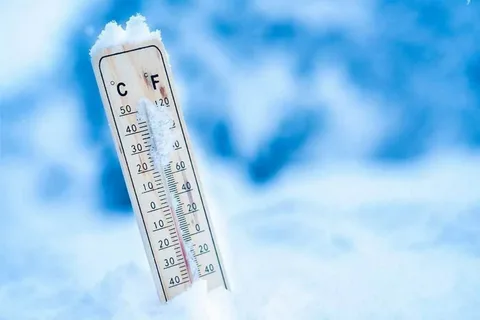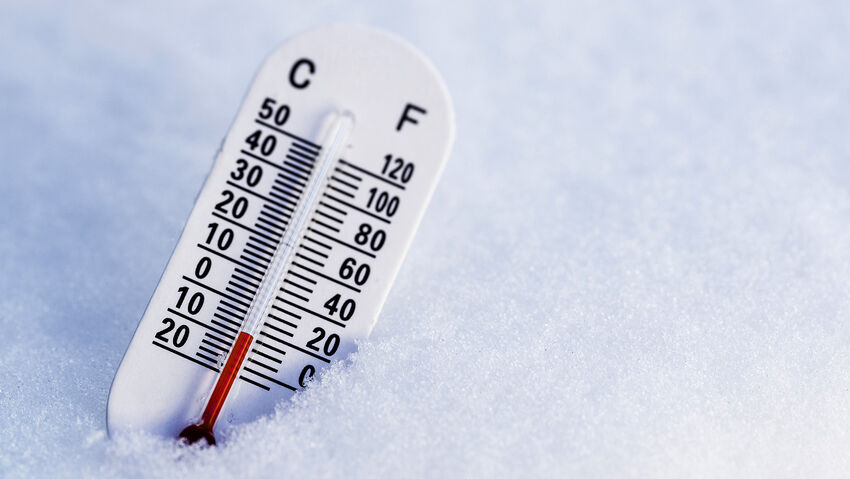When temperatures drop far below freezing, the numbers start to look a little scary. Whether you’re checking the weather before heading outside or reading about record lows in the Arctic, you might wonder how Celsius and Fahrenheit compare. One question that regularly sparks confusion is this: which is colder, -40°C or -40°F?
The surprising answer is that at minus 40, both temperature scales actually meet. But understanding why they meet, and how the two systems differ more broadly, requires a deeper dive into the science of temperature, history of measurement systems, and how these differences play out in the real world.
Let’s unpack everything you need to know about -40°C versus -40°F—and learn more about what extreme cold actually feels like.
Understanding Temperature Scales
The origins of Fahrenheit and Celsius
To compare -40°C and -40°F properly, it’s helpful to understand where these temperature scales come from.
Fahrenheit was developed in the early 18th century by German physicist Daniel Gabriel Fahrenheit. He based the scale on three fixed points: the freezing point of a saltwater solution (0°F), the freezing point of water (32°F), and the average human body temperature (around 98°F).
Celsius, developed by Swedish astronomer Anders Celsius in the mid-18th century, is based on the freezing (0°C) and boiling points (100°C) of water at standard atmospheric pressure. Celsius is part of the metric system, making it the more widely used temperature scale outside the United States.
The two systems reflect different ways of measuring the same physical phenomenon—how hot or cold something is—but they assign different numbers to each temperature.
How the scales compare mathematically
The relationship between Celsius and Fahrenheit can be calculated with this formula:
- Fahrenheit = (Celsius × 9/5) + 32
- To convert from Fahrenheit to Celsius:
- Celsius = (Fahrenheit – 32) × 5/9
- Let’s use this to figure out how -40 behaves in each system.
The Point Where Celsius and Fahrenheit Meet
Calculating the convergence point
To find out when Celsius and Fahrenheit temperatures are equal, you can set the conversion formulas equal to each other:
C = (C × 9/5) + 32
Solving this:
C = (9C/5) + 32
Multiply both sides by 5:
5C = 9C + 160
Subtract 9C from both sides:
-4C = 160
Divide both sides by -4:
C = -40
So, -40°C is exactly equal to -40°F.
That’s right—neither is colder than the other. They are the same temperature.
Why this intersection matters
This rare point of agreement makes -40 a popular trivia question, but it also helps to highlight the broader differences between the scales. As temperatures move away from -40, the values diverge significantly. For example:
- -30°C = -22°F
- -50°C = -58°F
- 0°C = 32°F
- 100°C = 212°F
Understanding this divergence is essential when comparing weather conditions across regions that use different scales.
How Cold Is -40, Really?
Experiencing -40 in real life
While it may seem like just a number, -40 degrees—on either scale—is incredibly cold. To put it into perspective:
- At -40°, exposed skin can get frostbite in less than 10 minutes.
- Most car engines will struggle to start unless equipped with engine block heaters.
- Many plastics and rubbers will become brittle and break.
- Railroads may need to halt service, as metal rails contract and become brittle.
- Even fuel can gel in diesel engines, making them unusable without additives.
Where on Earth does it get to -40?
Some places experience -40 or even lower on a regular basis. Examples include:
- Yakutsk, Russia – Frequently records winter temperatures below -40°C. It’s one of the coldest inhabited cities on Earth.
- Fairbanks, Alaska (USA) – Known for winter lows that can reach -40°F.
- Canadian Prairies (e.g., Winnipeg, Regina) – Winter cold snaps often see temperatures dip to -40, especially with wind chill.
So yes, humans have survived in -40 degrees, but it requires serious preparation.
Comparing Celsius and Fahrenheit at Other Temperatures
Room temperature and boiling points
Let’s look at how Celsius and Fahrenheit differ at more common temperature levels:
Room temperature:
- Celsius: ~21°C
- Fahrenheit: ~70°F
Freezing point of water:
- Celsius: 0°C
- Fahrenheit: 32°F
Boiling point of water:
- Celsius: 100°C
- Fahrenheit: 212°F
This shows how Fahrenheit assigns larger numbers for typical ranges, which some argue allows for greater precision without using decimals. For example, a 1-degree difference in Fahrenheit is smaller than in Celsius, making it useful in some meteorological contexts.
What about extreme heat?
In extreme heat, the divergence is just as noticeable:
- 40°C = 104°F
- 50°C = 122°F
- 60°C = 140°F
So while -40 is a point of agreement, the two scales behave quite differently at both high and low ends.
Why the United States Uses Fahrenheit
Historical roots of Fahrenheit in America
The United States remains one of the few countries that still uses Fahrenheit for everyday temperature reporting. This is mostly due to historical momentum. The U.S. adopted Fahrenheit before the metric system became the global standard, and inertia kept it in place.
Other countries like Canada and the UK used Fahrenheit well into the 20th century but eventually switched to Celsius as part of broader metrication efforts.
Pros and cons of each system
Fahrenheit Pros:
- More granularity between temperatures (smaller degree size).
- Considered more intuitive for daily life in certain climates (e.g., 0°F is very cold, 100°F is very hot).
Celsius Pros:
- Tied to the metric system, which is used worldwide.
- Easier scientific calculations (based on water’s freezing/boiling points).
- More intuitive for those who understand the 0–100 scale logic.
Despite the pros of Celsius, changing systems in a country as large as the U.S. would involve massive logistical and cultural hurdles.
The Science Behind Extreme Cold
What happens to the human body at -40?
- Respiratory effects: Breathing in air this cold can dry out and inflame airways, potentially triggering asthma-like symptoms.
- Hypothermia risk: The body loses heat rapidly, especially if wet or wind-exposed.
- Frostbite: Blood vessels constrict to preserve core temperature, which deprives extremities of warmth. Skin and underlying tissues can freeze quickly.
How do materials behave?
- Metals: Contract and can become brittle.
- Plastics: May shatter or deform under pressure.
- Glass: Becomes more prone to cracking.
- Batteries: Operate less efficiently; capacity drops significantly.
This is why aerospace, automotive, and infrastructure industries must test equipment for performance in sub-zero temperatures.
Beyond Earth: Coldest Temperatures in the Universe
Outer space temperatures
In deep space, temperatures plunge to around -270°C (-454°F)—just a few degrees above absolute zero. This is where Kelvin becomes the more relevant scale:
- 0 Kelvin = -273.15°C = -459.67°F
Absolute zero is the theoretical temperature at which atomic motion stops completely.
Coldest places observed
- Boomerang Nebula: Known as the coldest natural place in the universe. Estimated temperature: 1 Kelvin (-272°C).
- Lunar South Pole: Some shadowed craters stay at -250°F (-157°C) or lower.
So while -40 feels extreme on Earth, it’s still balmy compared to deep space.
Misconceptions About Temperature and Perception
Wind chill vs actual temperature
People often confuse wind chill with actual temperature. Wind chill represents how cold it feels to human skin due to wind removing heat from the body. For example:
- Actual temp: -20°F
- Wind chill: -40°F
But the thermometer still reads -20°F. Wind chill is useful for public health messaging but not for scientific comparisons.
Dry cold vs humid cold
You’ve probably heard someone say, “It’s a dry cold.” That’s more than just a saying:
- Dry cold (e.g., Arctic regions) may feel less bone-chilling because there’s less moisture in the air.
- Humid cold (e.g., coastal areas) can feel more penetrating even if the thermometer reads a milder number.
However, this is more about perception than actual temperature differences.
Fun Facts About -40
Aviation and engineering
- Jet fuel remains usable down to around -40°C, which is critical for high-altitude flights.
- Commercial airliners cruise in temperatures around -40 to -60°C at 35,000 feet.
Cultural references
- In Canada, -40 is almost a badge of honor. Locals might say, “It’s minus 40—time to put on a second pair of socks!”
- In the U.S., cities like Minneapolis or Fargo cancel school or delay transit around -40°F.
It’s not just a number; it’s a lifestyle in some parts of the world.
Final Thoughts
At the end of the day, the answer to the question “Which is colder: -40°C or -40°F?” is both simpler and more interesting than you might think. They are exactly the same temperature—a rare intersection between two very different temperature scales.
This fact provides a perfect starting point for understanding how temperature is measured, perceived, and lived in different parts of the world. It also underscores how extreme weather conditions demand respect and preparation, no matter what scale you’re using.
So the next time you see -40 on a thermometer, you can feel just a little bit smarter—and a whole lot colder—knowing you’re witnessing a unique moment where science and trivia meet.
- Evan Name Meaning - June 5, 2025
- Virginia’s Most Popular THC Infused Drinks - June 5, 2025
- Nebraska’s THC Infused Seltzer Recommendations - June 4, 2025







